Introduction to Numbers Class 4 Notes Maths
What are Numbers?
Numbers are symbols we use to represent amounts and quantities. They help us count, measure, and do math.
Examples include:
- Counting numbers (1, 2, 3)
- Whole numbers (0, 1, 2), and
- Digits (0-9).
 Numbers
Numbers
Numeration: Numeration is all about understanding and working with numbers. It includes how we write, read, and understand numbers.
Here are the different ways of representing numbers:
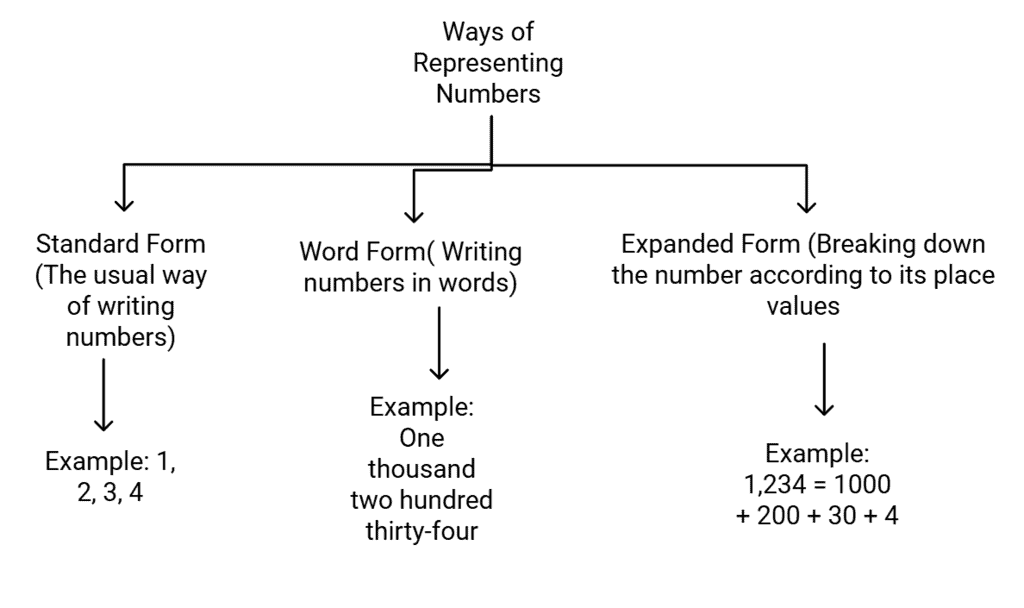 Different Ways of Representing Numbers
Different Ways of Representing Numbers
Place Value and Face Value
What is Place Value?
Place value defines the value of each digit in a number based on its position. Each position, or "place," in a number has a unique value that helps determine the overall number.
Example 1: What are the place values of each digit in the number 92,735?
Ans:
- 5 is Ones
- 3 is Tens
- 7 is Hundreds
- 2 is Thousands
- 9 is Ten thousands
The diagram below illustrates the above example in more detail.
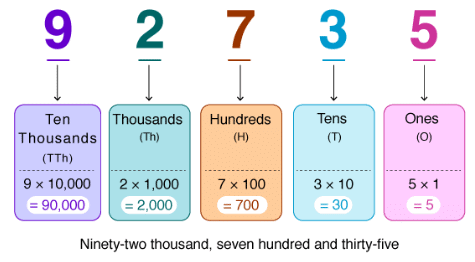 Place Value
Place Value
What is Face Value?
Face value is the actual value of the digit itself, no matter where it is in the number. It doesn't change based on the position of the digit.
Example 2: What are the face values of each digit in the number 472?
Ans:
- The face value of the digit 4 is 4.
- The face value of the digit 7 is 7.
- The face value of the digit 2 is 2.
So, no matter where a digit is placed in the number, its face value remains the same.
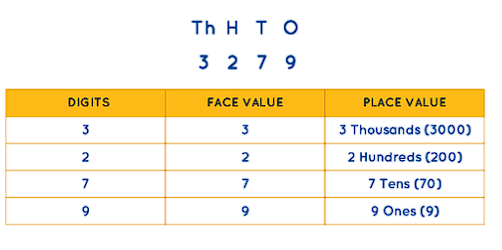 Face Value and Place Value
Face Value and Place Value
Ans:
 Place Values and Face Values of each digit
Place Values and Face Values of each digit
Place Value Chart: Indian and International Systems
A place value chart helps us see how much each digit in a number is worth based on where it is located.
- The chart arranges numbers into columns, with each column showing a different value, like units, tens, hundreds, and thousands.
- In the Indian and International systems, the chart looks a little different, but it helps us understand numbers better in both ways. Using this chart, we can easily see the value of each digit in a number!
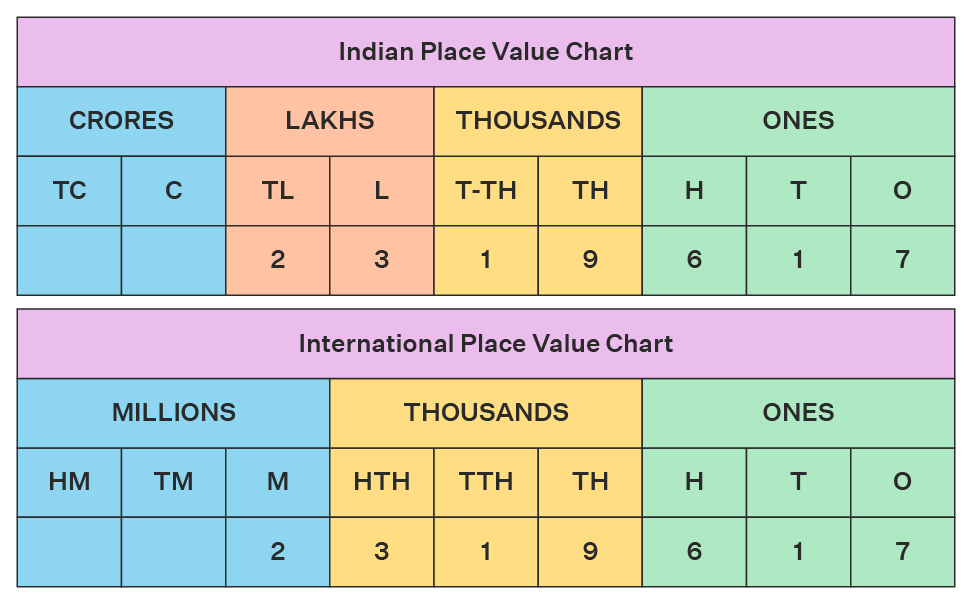 Place value charts of number 2319617
Place value charts of number 2319617
Indian System
In the Indian system, numbers are grouped into hundreds, thousands, lakhs, crores, and so on. Here’s a breakdown:
- Units: The first three digits from the right are the units, tens, and hundreds.
- Thousands: The next two digits are the thousands.
- Lakhs: The next two digits are the lakhs.
- Crores: The digits after lakhs are the crores.
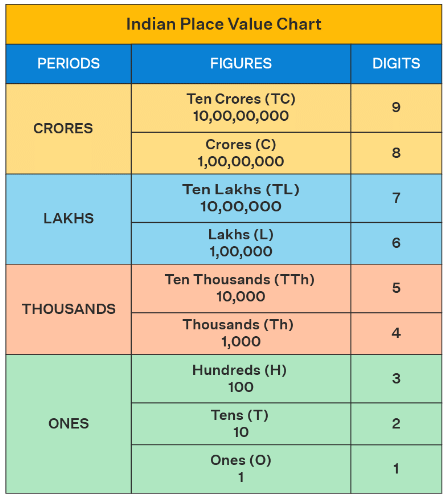 Indian Place Value Chart
Indian Place Value Chart
Example 4: How can we break down the number 12,34,567 using the Indian place value system?
Sol: Breaking down the number 1,234,567 in the Indian place value system:
- 12 lakhs
- 34 thousand
- 567 units
So, 12,34,567 is read as "Twelve lakh thirty-four thousand five hundred sixty-seven."
International System
In the International system, numbers are grouped into thousands, millions, billions, and so on. Here’s a breakdown:
- Units: The first three digits from the right are the units, tens, and hundreds.
- Thousands: The next three digits are the thousands.
- Millions: The next three digits are the millions.
- Billions: The digits after millions are the billions.
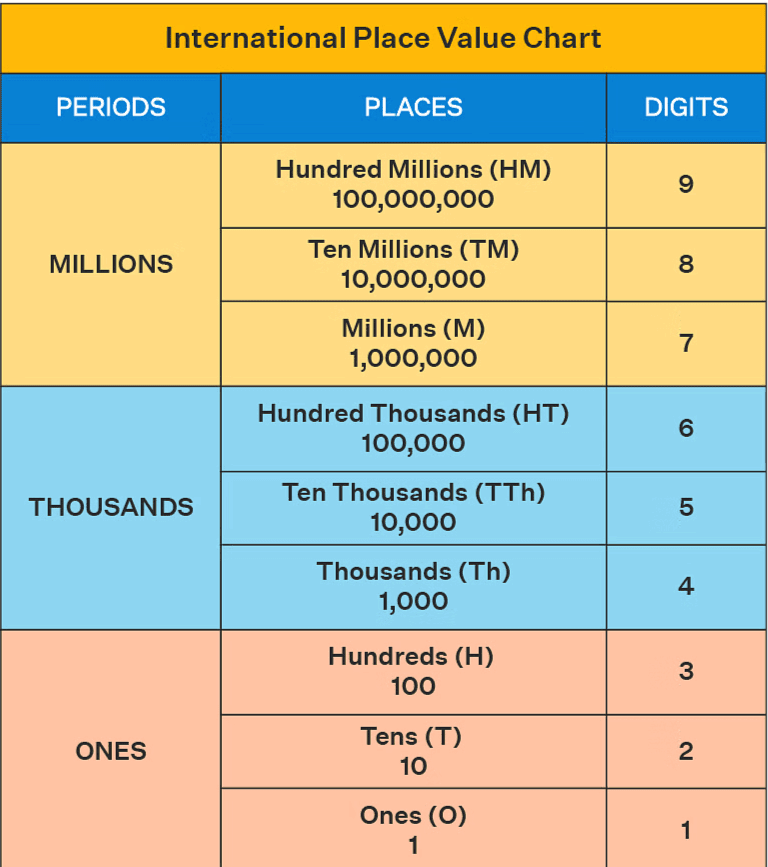 International Place Value Chart
International Place Value Chart
Example 5: How can we break down the number 1,234,567 using the International place value system?
Ans: Breaking down the number 1,234,567 in the International place value system:
- 1 million
- 234 thousand
- 567 units
So, 1,234,567 is read as "One million two hundred thirty-four thousand five hundred sixty-seven."
Example 6: Compare the two systems with this number: 53,21,678
Ans: Indian System:
- Units: 678
- Thousands: 21 (21 thousand)
- Lakhs: 53 (53 lakh)
Reading: Fifty-three lakh twenty-one thousand six hundred seventy-eight
International System:
- Units: 678
- Thousands: 321 (321 thousand)
- Millions: 5 (5 million)
Reading: Five million three hundred twenty-one thousand six hundred seventy-eight
Example 7: How can we break down and compare the numbers 7,50,000 in the Indian system and 750,000 in the International system step-by-step?
Ans: Indian System
In the Indian system, the number 7,50,000 is read as "Seven lakh fifty thousand." Here’s how we organize it:
- Units: The first three digits from the right represent the units, tens, and hundreds.
- Thousands: The next two digits represent the thousands.
- Lakhs: The next two digits represent the lakhs.
For the number 7,50,000:
- 7 is in the lakhs place.
- 50 is in the thousands place.
Thus, 7,50,000 can be broken down into:
- 7 lakhs
- 50 thousand
International System
In the International system, the same number is written as 750,000 and read as "Seven hundred fifty thousand." Here’s how we group it:
- Units: The first three digits from the right represent the units, tens, and hundreds.
- Thousands: The next three digits represent the thousands.
For the number 750,000:
- 750 is in the thousands place.
So, 750,000 can be expressed as:
- 750 thousand
Step-by-Step Conversion
Converting from the Indian System to the International System
- Identify the Groups: Break down the number in the Indian system into its respective groups—lakhs, thousands, and units.
- Re-group for the International System: Combine these groups to align with the International system.
Example: Convert 7,50,000 (Indian) to 750,000 (International)
- In the Indian system, this is represented as 7 lakhs + 50 thousand.
- When combined for the International system, it becomes 750 thousand.
Converting from the International System to the Indian System
- Identify the Groups: Break down the number in the International system into its respective groups—thousands and units.
- Re-group for the Indian System: Separate these groups to fit the Indian numbering format.
Example 8: Convert 750,000 (International) to 7,50,000 (Indian)
- In the International system, this is expressed as 750 thousand.
- When separated for the Indian system, it is represented as 7 lakhs + 50 thousand.
This systematic breakdown helps us understand the differences between the two numbering systems and allows for easy conversions.
How to Read and Write 5-Digit Numbers?
We know that 9,999 is the largest 4-digit number. If we add 1 to it, we get 10,000, which is the smallest 5-digit number.
- This also leads to a new place called the ten-thousands place. 10,000 is read as ten thousand.
Look at the following books:
- There are 10 books with 1,000 pages in each book.
- We say that there are 10 thousand = 1 ten thousand = 10,000 pages in all.
- Thus, 10 thousands = 1 ten thousand = 10,000.
- The following abacus will help you to understand the above:

Instructions to Follow
1. Count by Ten thousands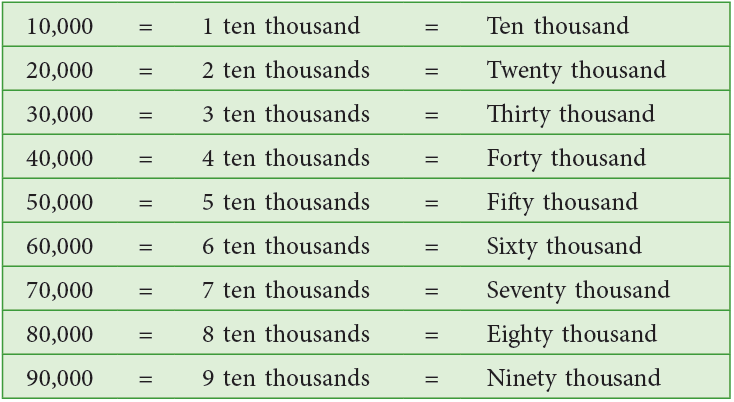
2. Forming 5-Digit Numbers
- If we add 1 to the smallest 5-digit number, 10,000, we get
10,000 + 1 = 10,001 (which is read as ten thousand one). - If we add 1 to 10,001, we get 10,001 + 1 = 10,002 (which is read as ten thousand two)
- 99,998 + 1 = 99,999 (which is read as ninety-nine thousand nine hundred ninety-nine).
- 99,999 is the greatest 5-digit number.
- If we add 1 to this number, we get 99,999 + 1 = 1,00,000 which is read as 100 thousands or 1 lakh.
This number has 6 digits. - 1,00,000 is the smallest 6-digit number.
Edurev Tips:
- Ones Period: Ones, Tens, Hundreds
- Thousands Period: Thousands, Ten Thousands
3. Writing 5-Digit Numbers
- We split up a large number into groups or periods starting from the right to make it easy to read and write.
- For a 5-digit number, the first three places from the right make the ones period and the next two make the thousands period. We separate the periods using commas or leave a short space.
- Thus, the number 18730 can be written as 18,730 or 18 730.
4. Reading 5-Digit Numbers
- While reading a number, all the digits in the same period are read together and the name of the period (except the ones) is read with the digits.
- Let us read the number 36,207.
- We arrange the digits of given number in the place value chart, as shown below.

We have, 36,207 = Thirty-six thousand two hundred seven.
Similarly, 50,327 = Fifty thousand three hundred twenty-seven. - We can represent the above numbers on the abacus, as shown below:
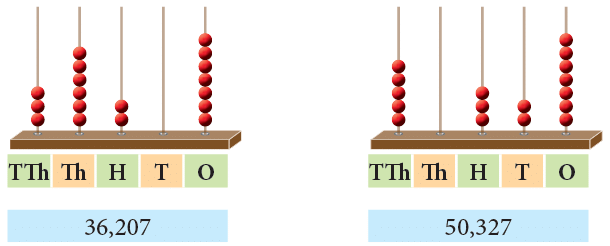
How to Read and Write 6-Digit Numbers?
To write the smallest 6-digit number, 1 lakh or 100000, using commas, we proceed as under:
- Starting from the right, we put a comma after three digits and then another comma after the fifth digit.

We represent the smallest 6-digit number 1,00,000, in the Indian place value chart, as shown below:
1 is in the lakhs place. So, 1,00,000 is read as 1 lakh.
Instructions to Follow
1. Counting in Lakhs
2. Forming 6-Digit Numbers
- 6-digit numbers beyond 1,00,000 can be formed as follows.
1,00,000 + 1 = 1,00,001 (One lakh one);
1,00,001 + 1 = 1,00,002 (One lakh two);
1,11,110 + 1 = 1,11,111 (One lakh eleven thousand one hundred eleven),…,
9,99,998 + 1 = 9,99,999 (Nine lakh ninety-nine thousand nine hundred ninety-nine);
9,99,999 is the greatest 6-digit number. - In a 6-digit number, the first three places from the right make the ones period, the next two make the thousands period and the next, that is, the sixth place, makes the lakhs period.
- We may put a comma between different periods or leave space between them. Thus, ‘four lakh’ may be written as 4,00,000 or 4 00 000.
3. Representing 6-Digit Numbers on Abacus
- We can represent 6-digit numbers on the abacus, as follows.

- The abacuses shown above represent the numbers 1,00,001 and 3,48,726 and 7,03,189, respectively.
- They are read as one lakh one; three lakh forty-eight thousand seven hundred twenty-six and seven lakh three thousand one hundred eighty-nine, respectively.
How to Write in Expanded Notation?
Expanded Form: When we write a number in expanded form, we break it down to show the value of each digit. It's like stretching the number out to see each part clearly.
Example: Write in expanded form: 4,582
Sol: Let's expand 4,582:
- Thousands place: The digit 4 is in the thousands place, so its value is 4,000.
- Hundreds place: The digit 5 is in the hundreds place, so its value is 500.
- Tens place: The digit 8 is in the tens place, so its value is 80.
- Ones place: The digit 2 is in the ones place, so its value is 2.
Putting it all together:
4,582 = 4,000 + 500 + 80 + 2
Edurev Tips: In expanded notation, a number is written as the sum of the place values of its digits.
Writing Numbers in Compact Form
Compact Form: When we write a number in compact form, we combine all the parts back together to form the standard number. It's like compressing the stretched-out number back into its original form.
Example: Write in Compact Form: 5,000 + 300 + 20 + 4
Sol: Let's compact this number:
Add the values together:
5,000 + 300 + 20 + 4Sum up to get the compact form:
5,000 + 300 = 5,300
5,300 + 20 = 5,320
5,320 + 4 = 5,324
So, 5,000 + 300 + 20 + 4 = 5,324
How to Compare and Ordering Numbers?
Case 1: Comparing Numbers with Different Number of Digits
Rule: A number containing greater number of digits is larger than a number containing lesser number of digits.
54,207 > 8,964
(5 digits) (4 digits)
Example: Which is the greatest: 3,815 or 567 or 36,812?
Ans:
If you write these numbers on the number line, the number 567 will come first, then 3,815 and then 36,812, from the left to right. Since 567 is to the left of 3,815, therefore, 567 < 3,815 or 3,815 > 567.
Also, since 3,815 is to the left of 36,812, therefore, 3,815 < 36,812 or 36,812 > 3,815.
Therefore, 36,812 is the greatest.
Case 2: Comparing Numbers with Same Numbers of Digits
Rule: To compare numbers with equal number of digits, start by comparing the digits from the leftmost place till you find two different digits. Compare these digits to decide the greater and smaller of the given numbers.
Example: Which is greater: 32,719 or 45,989?
Ans:
Both are 5-digit numbers but the number 32,719 has 3 ten thousands, while the number 45,989 has 4 ten thousands.
Since 4 ten thousands is greater than 3 ten thousands, therefore, 45,989 > 32,719.
Example: Which is greater: 7,32,612 or 7,32,545?
Ans:
Both the numbers are 6-digit numbers and both have 7 lakh 32 thousands. But the number 7,32,612 has 6 hundreds, while the number 7,32,545 has 5 hundreds.
Therefore, 7,32,612 > 7,32,545.
How to Write in Ascending and Descending Orders?
- Numbers, when arranged from the smallest to the greatest, are said to be in ascending order.
- Numbers, when arranged from the greatest to the smallest, are said to be in descending order.
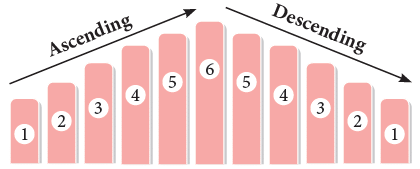
Example: Arrange the following numbers in ascending order.
12,675 6,532 62,392 18,125 29,358
Ans:
The smallest number is 6,532. The next number greater than 6,532 is 12,675. The next number greater than 12,675 is 18,125. The other numbers greater than 18,125 in order are 29,358 and 62,392.
∴ 6,532 < 12,675 < 18,125 < 29,358 < 62,392.
Hence, the above numbers when arranged in ascending order are:
6,532 12,675 18,125 29,358 62,392.
What is Successor and Predecessor?
- The successor of a whole number is the number obtained by adding 1 to it. So, the successor of 0 is 1, the successor of 1 is 2, and so on.
- The predecessor of a whole number is one less than the given number. So, the predecessor of 1 is 0, the predecessor of 2 is 1, and so on.
Look at some examples of successor and predecessor of a number:
How to Form Numbers using the Given Digits?
1. Smallest Number
To write the smallest number using the given digits, arrange the digits in ascending order.
- If 0 is one of the digits, it takes the second place after the smallest digit.
- If two of the given digits are equal, then write them one after the other.
2. Greatest Number
To write the greatest number using the given digits, arrange the digits in descending order.
- If two of the given digits are equal, write them one after the other.
Edurev Tips: Zero occupies the second highest position in forming the smallest number.
Example: Use 6, 2, 1, 8 to build the greatest and the smallest 4-digit numbers.
Ans:
Greatest number: Arranging the digits in descending order, we get 8,621.
Smallest number: Arranging the digits in ascending order, we get 1,268.
Example: Use 1, 5, 0, 8, 3 to build the greatest and the smallest 5-digit numbers.
Ans:
Greatest number: 85,310, Smallest number: 10,358
How to Round off the Numbers?
In our daily life, we hear statements like the following:
- Sarita said that she weighs about 40 kg. She weighs 41 kg.
- Mr Dubey paid ₹ 675 for a coat. To his friend, he said, “The coat cost me nearly ₹ 700.”
- About 25,000 people watched the IPL match. 24,750 people watched the match.
In all the statements given above, the given number is being replaced by another number that is “close to” or is an approximation of it. This is called rounding off the given number to a chosen place value. In the first statement, the given number is rounded off to the nearest ten and in the second and third statements, the given number is rounded off to the nearest hundred.
1. Rounding off the Numbers to the Nearest Ten
To round off a number to the nearest ten, we round it off to the multiple of ten nearest to it.
In general, for rounding off a number to the nearest ten, look at the digit in the ones place. If it is 1, 2, 3 or 4, then round down the number to the lesser ten. If the digit is 5, 6, 7, 8 or 9, then round up the number to the greater ten.
Example:
- 57 is rounded off to 60. Ones digit is 7, so round up to the greater ten.
- 512 is rounded off to 510. Ones digit is 2, so round down to the lesser ten.
- 1,965 is rounded off to 1,970.
- 12,785 is rounded off to 12,790.
2. Rounding off the Numbers to the Nearest Hundred
To round off a number to the nearest hundred, we round it off to the multiple of hundred nearest to it.
In general, for rounding off a number to the nearest hundred, look at the digit at the tens place. If it is 1, 2, 3 or 4, round down to the lesser hundred. If the digit is 5, 6, 7, 8 or 9, round up to the greater hundred.
Examples:
- 729 is rounded off to 700. Tens digit is 2, so round down.
- 1,550 is rounded off to 1,600. Tens digit is 5, so round up.
- 24,874 is rounded off to 24,900. Tens digit is 7, so round up.
- 84,214 is rounded off to 84,200.
3. Rounding off the Numbers to the Nearest Thousand
To round off a number to the nearest thousand, we round it off to the multiple of thousand nearest to it.
In general, for rounding off a number to the nearest thousand, look at the digit at the hundreds place. If it is 1, 2, 3 or 4, round down to the lesser thousand. If the digit is 5, 6, 7, 8 or 9, round up to the greater thousand.
Example:
- 8,958 is rounded off to 9,000. Hundreds digit is 9, so round up.
- 16,349 is rounded off to 16,000. Hundreds digit is 3, so round down.
- 29,500 is rounded off to 30,000.
Comma Placement
- Commas are used in large numbers to facilitate readability and writing. In both the Indian and international numeral systems, commas are positioned differently.
- In the Indian numeral system, the initial comma is inserted after the hundreds place, followed by additional commas every two digits. For example, 1,23,45,67,890.
- In the international numeral system, the initial comma is positioned after the hundreds place, and subsequent commas are added after every three digits. For instance, 1,234,567,890.
|
33 videos|92 docs|46 tests
|
FAQs on Introduction to Numbers Class 4 Notes Maths
| 1. What is the difference between place value and face value? |  |
| 2. How do you read and write a 5-digit number? |  |
| 3. What is expanded notation and how is it written? |  |
| 4. How do you round off numbers? |  |
| 5. What are successor and predecessor in numbers? |  |

















